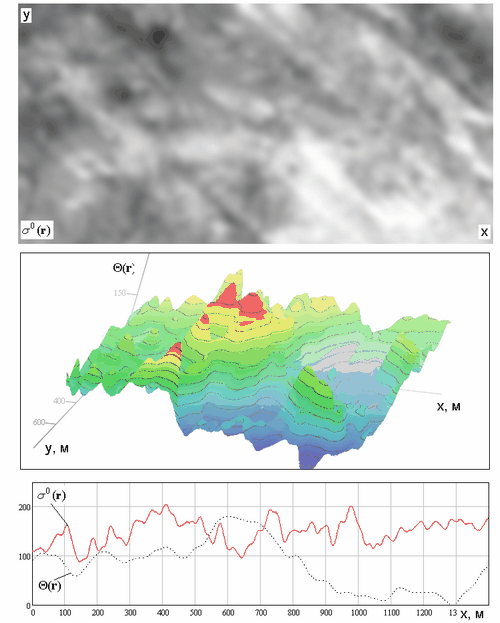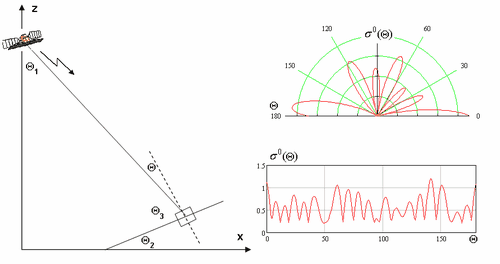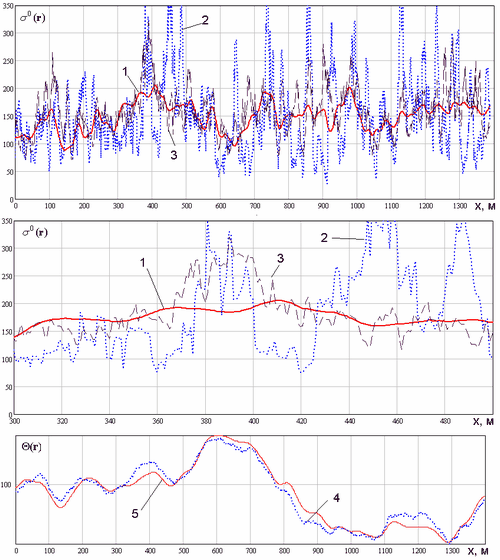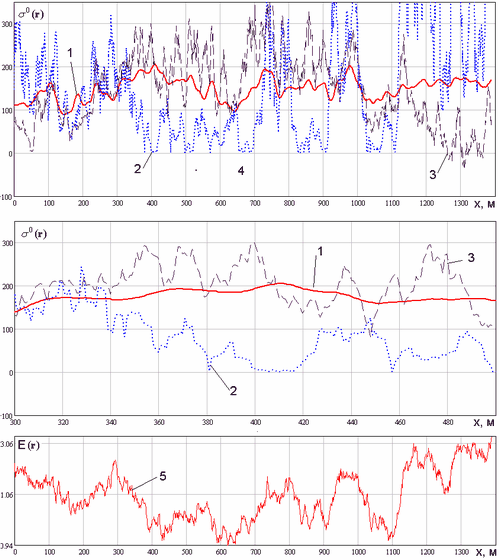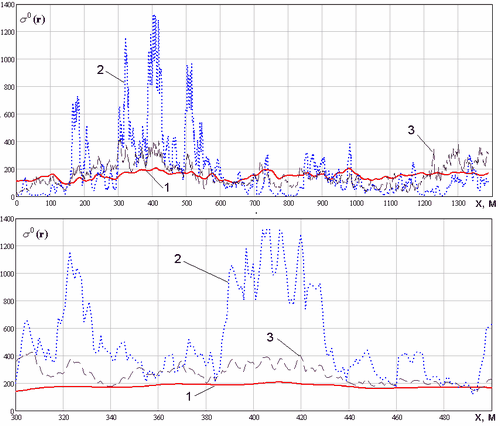|
|
Multiposition Synthetic Aperture Radar (MPSAR) Alexander V Ksendzuk |
|
|
( |
| Main Page |
4. Multiposition SAR. Optimal signal processing.
Input
process in multiposition SAR is an addition of signal (vector of signals
scattered from the surface) and noise (vector of additive noises, which may be
approximated by Gaussian process)
For functionally-determined
surface models input process in an stochastic process with mean
In this section optimal Bayesian and maximum likelihood algorithms for the surface parameter estimation in the multiposition SAR are derived.
4.1. Optimal processing algorithm for functionally-determined surface models.
For this model mean (vector) of
the input process is the function of the parameters to be estimated
where
|
| Signal Model | |
| Geometry | |
| Optimal Signal Processing | |
| Object detection | |
| Multiposition SAR interferometer | |
| Pseudonoise signals in remote sensing systems | |
| Pseudo-passive SAR | |
| Remote sensing systems modeling principles | |
| About Author | |
| Links | |
|
With unknown a-priory distribution
of the estimated parameters to be estimated
Common equation for optimal parameter estimation is
This equation after some transformations may be simplified to the optimal monostatic or bistatic SAR processing algorithm. Exact parameter estimation algorithms may be found only for certain surface models (we still talking about functionally determined surface models). The most common model of the complex scattering coefficient is
where
Result of the optimal processing of the input vector
is equal to complexation function, smoothed by space ambiguity function of the multiposition system:
where space ambiguity function
Simplification of the optimal coprocessing algorithm in multiposition SAR (4.4) allow to achieve clear methods for the parameter estimation: 1. If additive noise vectors coordinates are delta-correlated time processes, which are independent in different receivers, optimal estimation of the complexation function is a weighted total of matched filtering of all receivers:
where dot in uppercase means
complex value, sign
If, additionally, energies of the
received signals and noise power spectral density are equal
4.2. Optimal processing algorithm for stochastic surface models.
With this model input signal
vector is the sum of two stochastic processes ¢ scattered signal vector
General optimal processing algorithm is given by
Simplification of the (4.6) is
based on dependence of input process vectorÆs mean
The case when only correlation
function and its determinant depend on parameters
where
In this case optimal processing algorithm will be quite complicated
However, in case when we estimate
radar cross-section
Consider surfaces which radar cross-section (as the function of the MPSAR parameters - bistatic angles, carrier frequencies, if we use transmitters with different carriers, polarization etc.) may be represented in a form
where
For the surface (4.15) result of the optimal processing
is equals to complexation function
and biased on value
In monostatic case this algorithm simplifies to modified synthetic aperture
4.3 Optimal processing algorithms estimation errors. In this section we compare results of the optimal processing in multiposition and monostatic SAR. Direct comparison has no sense because in multiposition system quality will be better due to statistical averaging, resulting in lower speckle noise level.
Comparison will be done in case of
ōdisturbancesö. Consider estimation of some electrophysical parameter (for
example humidity)
Figure 4.1.
Complexation function
Radar cross-section for arbitrary
bistatic pair depends on local incidence angle (or to be exact, for the
considered surface model
Figure 4.2.
Function
We will compare estimation of the
complexation function 1. Relief altitude and, correspondingly, local angle of slope of the surface and therefore local incidence angle measured with error. 2. Presence of the multiplicative atmospheric noise (in multiposition SAR noises in each bistatic pair are independent processes). 3. Both of 1 and 2 ōdisturbancesö. Results of the modeling and corresponding estimation errors are shown in Figure 4.3- Figure 4.5.
Figure. 4.3. Estimation of the complexation function (graph 1) in monostatic SAR (graph 2) and multiposition SAR (graph 3) in case when estimated surfaceÆs local angle of slope (graph 4) differs from its true value (graph 5).
Figure. 4.4. Estimation of the complexation function (graph 1) in monostatic SAR (graph 2) and multiposition SAR (graph 3) in case when multiplicative noise (caused by atmospheric effects) presence, realization of this multiplicative noise in one bistatic pair are shown in graph 5.
Figure. 4.5. Estimation of the complexation function (graph 1) in monostatic SAR (graph 2) and multiposition SAR (graph 3) in case when multiplicative noise (caused by atmospheric effects) and relief altitude estimation errors presence.
Conclusion. Optimal processing algorithms in multiposition SAR involves coprocessing (simultaneous processing of all data from all bistatic pairs), which allows significantly increase quality of the surface imaging (surface parameters estimation). As was shown in modeling MPSAR provides higher quality even if unknown errors in surface model and in input signal presented.
|
|
|
e-mail to author: Alexander V Ksendzuk |


















